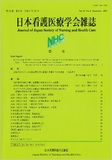Japanese
English
- 有料閲覧
- Abstract 文献概要
- 参考文献 Reference
要旨
目的:高齢者専門病院で働く看護職の尊厳死に対する認識を明らかにする。
方法:150床以下の高齢者専門病院2か所を対象に、看護職136名に対して質問紙調査を行った。
結果:尊厳死に対して、「よくわからない」と回答した者は45名(33.1%)と最も多く、次いで「法制化が必要である」41名(30.1%)であった。尊厳死に対する認識として、【本人・家族の思いや希望を尊重した死】、【過剰な治療を控え苦痛が少ない安らかな死】、【その人らしさを大切にした尊厳ある死】、【現代の日本において実現が難しい死】の4つのカテゴリーが抽出された。
考察:看護職は、尊厳死の実現を望んでいるが、終末期医療の在り方や尊厳死の定義など確立されていないことも多く、実現の困難性も認識していた。高齢者のエンド・オブ・ライフケア、つまり尊厳死の実現に向けての方策の一つには、アドバンス・ケア・プランニングやリビング・ウイルを推進していくことが示唆された。
Objective: To clarify the awareness of death with dignity of nurses working in geriatric hospitals.
Method: A questionnaire survey was conducted on 136 nurses working in two hospitals specializing in the elderly with 150 beds or less.
Results: For death with dignity, 45 (33.1%) answered that they were not sure, followed by 41 (30.1%) who needed legislation. As a recognition of death with dignity, [death that respects the thoughts and hopes of the person and family], [peaceful death with less pain and less overtreatment], [death with dignity that values the person's personality], [death that is difficult to realize in japan today] four categories were extracted.
Discussion: Nursing professionals want to achieve death with dignity, but in many cases the ideal form of end-of-life care and the definition of death with dignity have not been established, and they also recognized the difficulty of achieving it. It was suggested that advanced care planning and living wills should be promoted as one of the measures for the end of life care of the elderly, that is, the realization of death with dignity.
Copyright © 2021, Japan Society of Nursing and Health Care All rights reserved.


